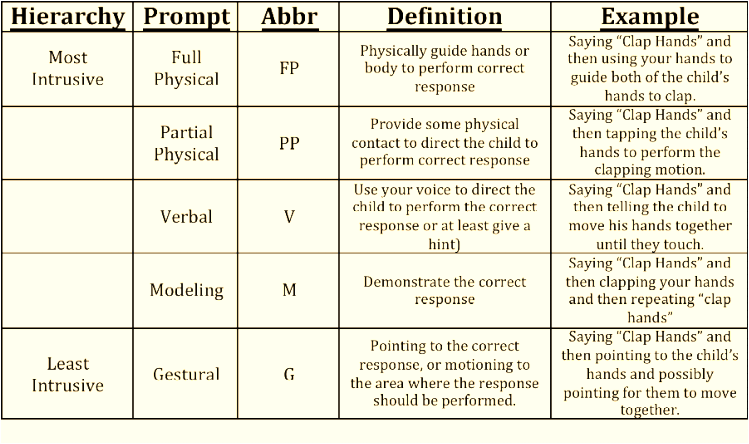
Many parents and professional have asked me about what the best way is to help a child with Autism Spectrum Disorder learn new skills. While there are different methods that are used within the field of applied behavior analysis, prompting is the most commonly used but also the most commonly misused.
Prompting is a way to get a child from responding incorrectly (or partially correctly) to responding correctly. Some of our children often aren't sure of what parts of the environment they should be responding to. Prompts help to highlight what children should respond to as well as when, and how much.
Prompts can be categorized into a hierarchy. At the top level, we have the most intrusive prompts where we are “intruding” on our child’s space maximally; however, we are not allowing our child to make any errors. This is important because, especially since when initially learning a skill, we want our child to experience as much success as possible. We also don't want our child to make an error and then practice the skill incorrectly.
At the bottom level we have the least intrusive prompts where we are “intruding” minimally on our child’s space but leaving the possibility of an error to be made. We typically will implement least intrusive prompts when we are relatively sure that the child will make few to no errors. The table below lists several of the prompts that I and families use while teaching our children.
Generally speaking, I prefer to use a process that is alternately named Most-to-Least Prompt Hierarchy Technique, also known as Errorless Learning, where we begin with the most intrusive prompt and then move down the hierarchy. The first attempt is prompted with the most intrusive prompt appropriate to help the student catch on to the new skill quickly. The first attempt is then followed by a second attempt, using a less intrusive prompt. The second successful, less prompted attempt is then reinforced.
Moving from a more intrusive prompt to a less intrusive prompt is referred to as prompt fading The ultimate goal is for our child to eventually not need any prompts and become independent with the skill at hand. As we watch our child become more awesome at a particular prompt level, the prompt is then faded to a less intrusive prompt. This ensures that the child does not become overly dependent on a particular prompt when learning a new skill.
We really try as much as possible to move as quickly as possible through the prompt levels, but not too quickly. Moving too fast could cause our child to learn the skill incorrectly. In general, we try to make sure that our child is successful with a prompt three to five times in a row before moving on to the next prompt level.
Prompting is a way to get a child from responding incorrectly (or partially correctly) to responding correctly. Some of our children often aren't sure of what parts of the environment they should be responding to. Prompts help to highlight what children should respond to as well as when, and how much.
Prompts can be categorized into a hierarchy. At the top level, we have the most intrusive prompts where we are “intruding” on our child’s space maximally; however, we are not allowing our child to make any errors. This is important because, especially since when initially learning a skill, we want our child to experience as much success as possible. We also don't want our child to make an error and then practice the skill incorrectly.
At the bottom level we have the least intrusive prompts where we are “intruding” minimally on our child’s space but leaving the possibility of an error to be made. We typically will implement least intrusive prompts when we are relatively sure that the child will make few to no errors. The table below lists several of the prompts that I and families use while teaching our children.
Generally speaking, I prefer to use a process that is alternately named Most-to-Least Prompt Hierarchy Technique, also known as Errorless Learning, where we begin with the most intrusive prompt and then move down the hierarchy. The first attempt is prompted with the most intrusive prompt appropriate to help the student catch on to the new skill quickly. The first attempt is then followed by a second attempt, using a less intrusive prompt. The second successful, less prompted attempt is then reinforced.
Moving from a more intrusive prompt to a less intrusive prompt is referred to as prompt fading The ultimate goal is for our child to eventually not need any prompts and become independent with the skill at hand. As we watch our child become more awesome at a particular prompt level, the prompt is then faded to a less intrusive prompt. This ensures that the child does not become overly dependent on a particular prompt when learning a new skill.
We really try as much as possible to move as quickly as possible through the prompt levels, but not too quickly. Moving too fast could cause our child to learn the skill incorrectly. In general, we try to make sure that our child is successful with a prompt three to five times in a row before moving on to the next prompt level.
 RSS Feed
RSS Feed